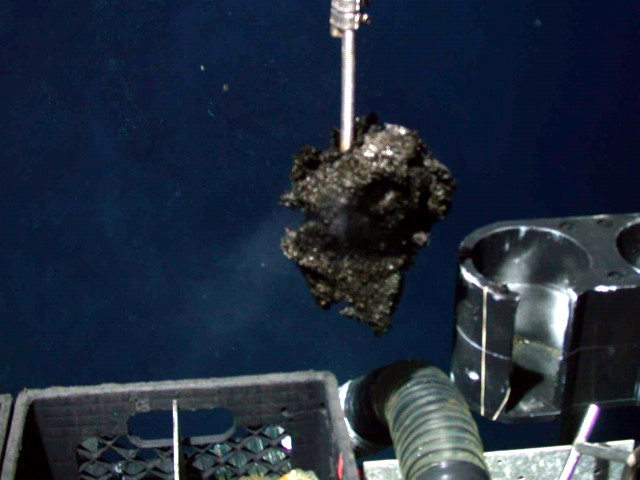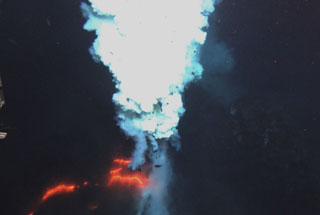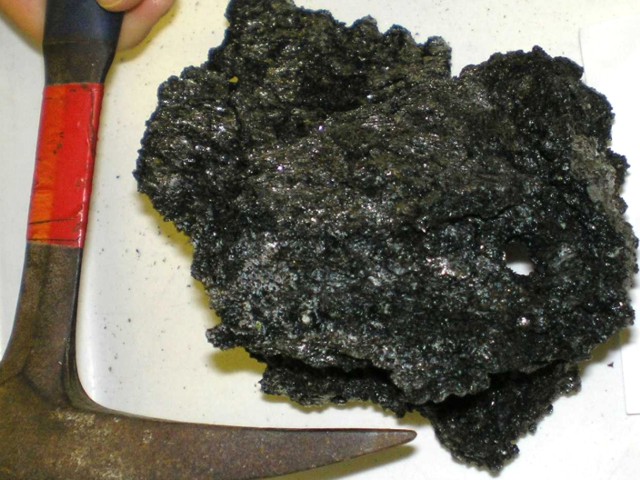Report on West Mata (Tonga) — December 2009
Bulletin of the Global Volcanism Network, vol. 34, no. 12 (December 2009)
Managing Editor: Richard Wunderman.
West Mata (Tonga) Deep submarine volcano found to be composed of boninite
Please cite this report as:
Global Volcanism Program, 2009. Report on West Mata (Tonga) (Wunderman, R., ed.). Bulletin of the Global Volcanism Network, 34:12. Smithsonian Institution. https://doi.org/10.5479/si.GVP.BGVN200912-243130
West Mata
Tonga
15.1°S, 173.75°W; summit elev. -1174 m
All times are local (unless otherwise noted)
The eruption of the submarine back-arc West Mata volcano was reported in May 2009 (BGVN 34:06) at 1,200 m water depth in the NE Lau basin. The activity was discovered during a research cruise aboard the University of Washington's RV Thomas Thompson.
Ken Rubin, a geochemist at the University of Hawaii, reported that during the 2009 cruise a remote operated vehicle (ROV Jason) was used to observe extrusive and mildly explosive (Strombolian, or the deep-submarine equivalent) activity near the summit. Among the many attributes of this event was the unique style of eruption from multiple active vents. In addition, the lavas were composed of boninite (a lava of olivine-bronzite andesite composition containing little or no feldspar), making this the first observed eruption of a lava of this composition. Such lavas have previously been seen only on volcanoes over a million years old, and are thought to represent the early stages of subduction in primitive island arcs. One of the tasks on the cruise was to sample an active lava pillow. Rubin provided several photographs of the sampling sequence, done with a T-handled rod rammed into a molten zone on the pillow (figures 4 and 5). Some of the sample has been distributed for analysis.
 |
Figure 4. Photograph taken from the ROV Jason of a sample of lava from West Mata being placed in a container aboard the vehicle. Courtesy of K. Rubin. |
According to press release 09-243 of 17 December 2009 by the National Science Foundation (NSF), the expedition's chief scientist and a chemical oceanographer at the University of Washington, Joseph Resing, stated that "we found a type of lava never before seen erupting from an active volcano, and for the first time observed molten lava flowing across the deep-ocean floor." Bob Embley, marine geologist at NOAAs' Pacific Marine Environmental Laboratory, noted that "since the water pressure at that depth supresses the violence of the volcano's explosions, we could get an underwater robot within feet of the active eruption." Imagery includes large molten lava bubbles ~1 m across bursting into cold seawater, glowing red vents exploding lava particles into the sea, and lava flows. Video images may be seen on a number of websites (such as NSF).
Water from the volcano was very acidic, and Tom Shank, a biologist from the Woods Hole Oceanographic Institution, found that shrimp were the only animals thriving in the vent water near the eruption. The press release from NSF included a video of the volcanic explosions.
Several papers pertaining to research conducted on the 2009 eruption of West Mata were presented at the 2009 American Geophysical Union Fall Meeting, 14-18 December 2009; titles and authors of abstracts are shown in the reference list below.
References. Caress, D.W., Thomas, H., Conlin, D., and Clague, D.A., 2009, Fine-scale morphology of West Mata volcano and the Northeast Lau Spreading Center, Lau Basin from AUV multibeam surveys, American Geophysical Union 2009 Fall Meeting abstract V51D-1731.
Clague, D.A., Rubin, K.H., and Keller, N.S., 2009, Products of submarine fountains and bubble-burst eruptive activity at 1200 m on West Mata volcano, Lau Basin, American Geophysical Union 2009 Fall Meeting abstract V43I-02.
Huber, J.A., Cantin, H., Resing, J., and Butterfield, D.A., 2009, Microbial communities in erupting fluids from West Mata volcano, Tonga Arc, American Geophysical Union 2009 Fall Meeting abstract V41I-07.
Keller, N.S., Rubin, K.H., Clague, D.A., Michael, P.J., Resing, J.A., Cooper, L.B., Shaw, A.M., Ono, S., and Tamura, Y., 2009, Sulfur in submarine eruptions: Observations and preliminary data from West Mata, NE Lau Basin, American Geophysical Union 2009 Fall Meeting abstract V43I-08.
Lin, H., Cowen, J.P., Butterfield, D.A., Embley, R.W., and Resing, J., 2009, Dissolved organic carbon distribution in two hydrothermal systems ? West Mata, NE Lau Basin during an eruption event and basement fluids from sediment-buried Juan de Fuca Ridge flanks, American Geophysical Union 2009 Fall Meeting abstract B21D-06.
Michael, P.J., Escrig, S., Rubin, K.H., Cooper, L.B., Langmuir, C.H., Clague, D.A., Keller, N.S., and Plank, T., 2009, Major and trace elements and volatiles in glasses from the 2009 Rapid Response Expedition to West Mata volcano and Northeast Lau spreading center (NELSC), American Geophysical Union 2009 Fall Meeting abstract V51D-1720.
Resing, J., Lupton, J., Embley, R., Baker, E., and Lilley, M. (compilers), 2009, Preliminary findings from the North Lau eruption sites, informal report, 2/5/09 (URL: http://www.ridge2000.org/science/downloads/email/Nlaupreliminaryfindings25.pdf).
Geological Summary. West Mata, a submarine volcano rising to within 1,174 m of the ocean surface, is located in the northeastern Lau Basin at the northern end of the Tofua arc, about 200 km SW of Samoa and north of the Curacoa submarine volcano. Discovered during a November 2008 NOAA Vents Program expedition it was found to be producing submarine hydrothermal plumes consistent with recent lava effusion. A return visit in May 2009 documented explosive and effusive activity from two closely spaced vents, one at the summit, and the other on the SW rift zone.
Information Contacts: Ken Rubin, NOAA, University of Hawaii; National Science Foundation (NSF) (URL: http://www.nsf.gov/); American Geophysical Union 2009 Fall Meeting.


